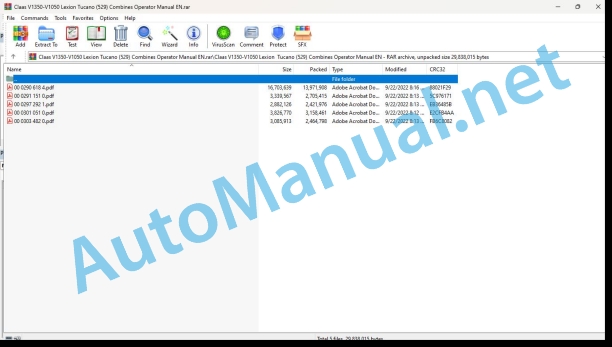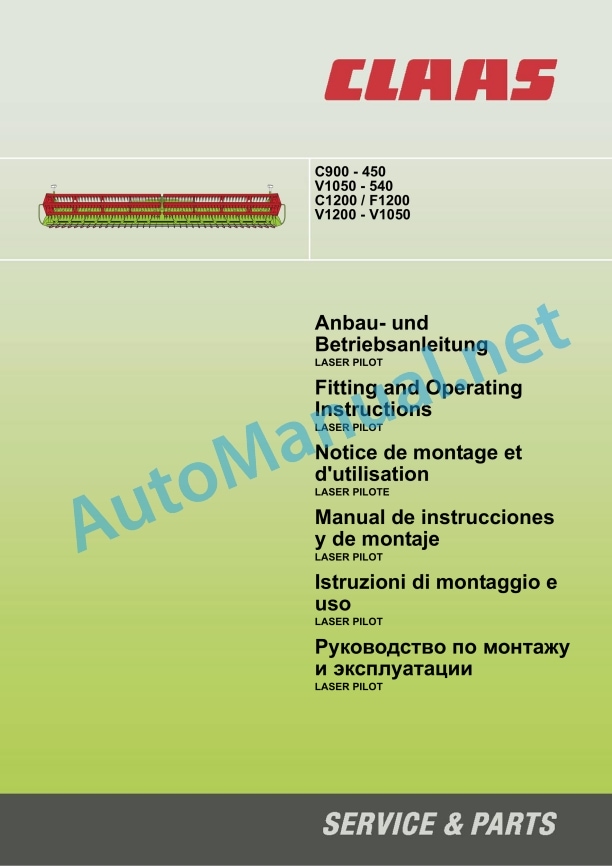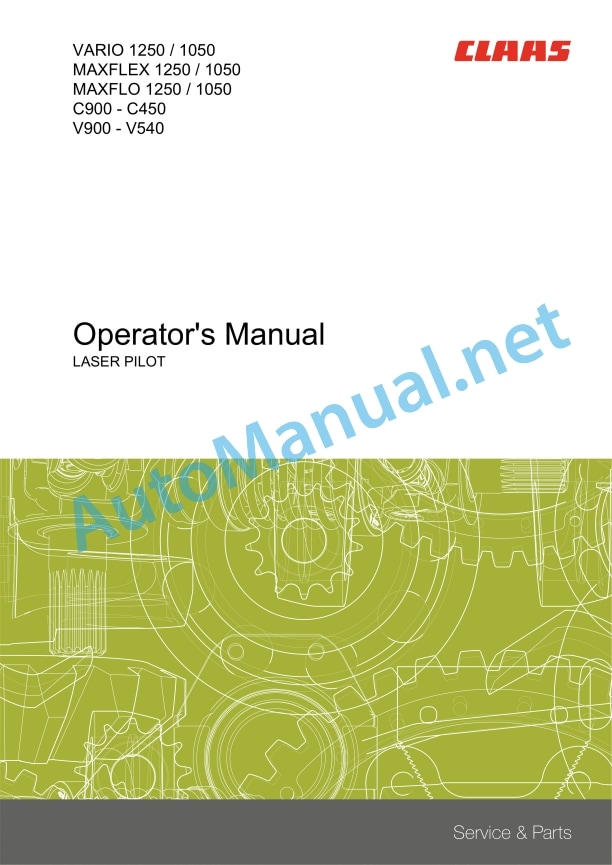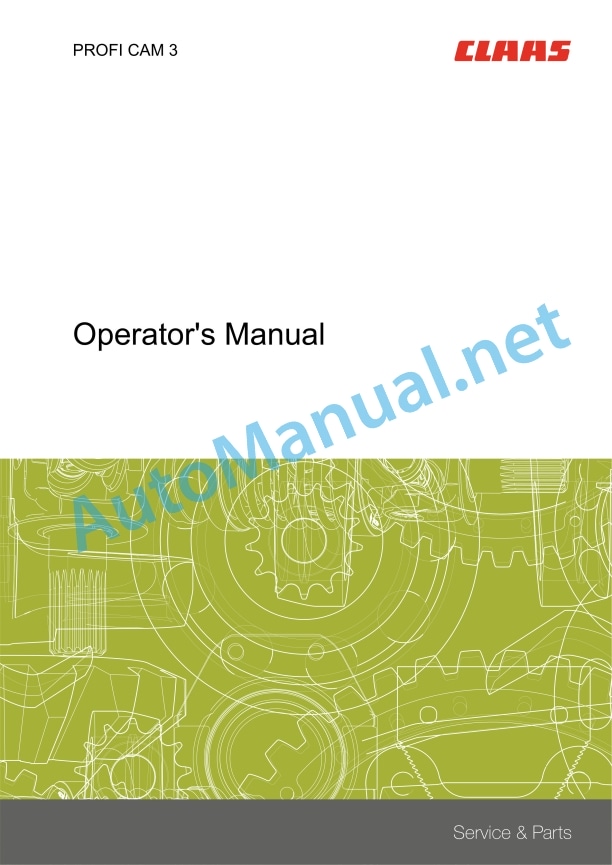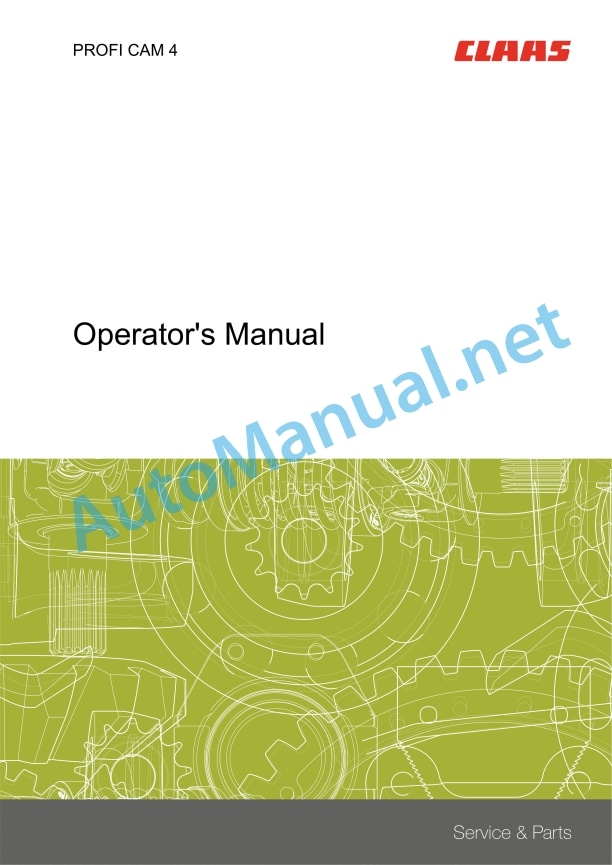Claas V1350-V1050 Lexion Tucano (529) Combines Operator Manual EN
$50.00
- Model: V1350-V1050 Lexion Tucano (529) Combines
- Type Of Manual: Operator Manual
- Language: EN
- Format: PDF(s)
- Size: 23.6 MB
File List:
00 0290 618 4.pdf
00 0291 151 0.pdf
00 0297 292 1.pdf
00 0301 051 0.pdf
00 0303 482 0.pdf
00 0290 618 4.pdf:
VARIO 1230VARIO 1200VARIO 1050
Table of contents
1 To this Operator’s Manual
1.1 Notes on the manual
1.1.1 Validity of this manual
1.1.2 Notes on this Operator’s Manual
1.1.3 Symbols and notes
1.1.4 Optional equipment
1.1.5 Qualified specialist workshop
1.1.6 Notes on maintenance
1.1.7 Notes on warranty
1.1.8 Technical specifications
1.1.9 Spare parts and technical questions
2.1 Intended use
2.1.1 Intended use
2.1.2 Reasonably foreseeable misuse
2.2 Safety rules
2.2.1 Operator’s Manual and other sources of information
Meaning of Operator’s Manual
2.2.2 Personnel qualification and organization
Requirements made on all persons working with the machine
2.2.3 Coupling of machines
Coupling of machines with front attachment or trailer
2.2.4 Alterations to the machine
Structural alteration
2.2.5 Additional equipment and spare parts
Additional equipment and spare parts
2.2.6 Technically flawless condition
Operation only following proper pre-delivery inspection
Operation only following proper putting into operation
Technically flawless condition of machine
Danger from damage on the machine
Complying with technical limit values
2.2.7 Hazard areas
Hazard areas
Standing between the machine and the front attachment
Danger when drive is engaged
Risk of injury on the universal drive shaft
2.2.8 Safety devices
Keeping the safety devices functional
2.2.9 Personal protective equipment
Personal protective equipment
Wearing suitable clothing
2.2.10 Safety markings
Keeping safety decals legible
2.2.11 Road safety
Preparing the machine for road travel
Unsupervised parking
Keeping the machine free of foreign objects
2.2.12 Operating liquids
Unsuitable operating liquids
Safe handling of operating and auxiliary liquids
Environmental protection and disposal
2.2.13 Sources of hazards on the machine
Electrocution by electric system
Liquids under pressure
Hot surfaces
2.2.14 Hazards when working on the machine
Working on the shut-down machine only
Maintenance work and repairs
Lifted machine parts and loads
Hazard from welding work
2.3 Safety instructions in this manual
2.3.1 Marking of warning and hazard notes
2.4 Safety decals on the machine
2.4.1 Notes on safety decals
2.4.2 Mowing unit
2.4.3 Crop pick-up
2.4.4 Drives
2.4.5 Various components / Machine body
2.5 Safety devices
2.5.1 Fitting the reel safety lock
2.5.2 Setting out the reel safety locks
2.5.3 Fitting the protective guard at the finger bar
3 Machine description
3.1 Overview and method of operation
3.1.1 VARIO overview
3.1.2 Function of VARIO
3.2 Optional machine equipment
3.2.1 Optional equipment
3.2.2 Rape cutting equipment transport box
3.3 Identification plates and identification number
3.3.1 Identification plate of front attachment
3.4 Information on the machine
3.4.1 Drives
3.4.2 Hydraulic system
3.4.3 Crop pick-up
3.4.4 Feeder
3.4.5 Mowing unit
3.4.6 Various components / Machine body
4 Operating and control elements
4.1 Cab and operator’s platform
4.1.1 Control panel
4.2 Crop feeding
4.2.1 Controls
5 Technical specifications
5.1.1 Compatible machines
5.1.2 Dimensions
5.1.3 Weights
5.1.4 Reel
5.1.5 Feeder
5.1.6 Mowing unit
5.1.7 Safety features
5.2 Operating utilities
5.2.1 Lubricants
5.2.2 Hydraulic oil
6 Machine preparation
6.1 Shutting down and securing the machine
6.1.1 Shut down and secure the machine
6.2 Prior to operation
6.2.1 Carry out prior to initial commissioning
6.2.2 Carry out prior to every operation
6.3 Loading the front attachment
6.3.1 Loading and lashing down the front attachment
6.4 Mounting front attachment
6.4.1 Installing the front attachment
6.4.2 Preparing the lock
6.4.3 Installing the locking pawl
6.4.4 Suspending the front attachment
6.4.5 Interlocking the front attachment
6.4.6 Installing the universal drive shaft
Checking the chain length
6.4.7 Mounting the multi-coupler
6.4.8 Removing the stands
6.4.9 Adjusting the machine to the front attachment
6.5 Removing front attachment
6.5.1 Removing the front attachment
6.5.2 Fitting the stands
6.5.3 Removing the multi-coupler
6.5.4 Removing the universal drive shaft
6.5.5 Unlocking the front attachment
6.5.6 Unhinging the front attachment
6.6 Steering
6.6.1 Installing the LASER PILOT*
6.7 Electrical and electronic system
6.7.1 Removing the AUTO CONTOUR* sensor band transport safety equipment
6.7.2 Installing the left rape cutter* switch
6.8 Crop feeding
6.8.1 Removing the reel transport safety equipment
6.9 Feeder unit
6.9.1 Adapting the scraper profiles to the feed rake conveyor
7 Operation
7.1 Safety precautions for operation
7.1.1 Avoiding collisions with the cab roof
7.2 Driving the machine
7.2.1 Preparing road travel
7.2.2 Preparing for fieldwork
7.3 Fieldwork
7.3.1 Prior to fieldwork
7.3.2 Checking the crop pick-up
7.4 Rape harvest
7.4.1 Installing the rape cutting equipment
7.4.2 Installing the rape cutting equipment universal drive shaft extension
7.4.3 Fitting the rape cutting equipment plates
7.4.4 Installing the rape cutter
7.4.5 Connecting the hydraulic system
7.4.6 Putting the hydraulic pump into operation
7.5 Grain harvest
7.5.1 Fitting the grain equipment
7.5.2 Putting the hydraulic pump out of operation
7.5.3 Disconnecting the hydraulic system
7.5.4 Removing the rape cutter
7.5.5 Removing the rape cutting equipment plates
7.5.6 Remove rape cutting equipment universal drive shaft extension
7.6 Steering
7.6.1 Folding out the LASER PILOT*
7.6.2 Folding in the LASER PILOT*
7.7 Crop feeding
7.7.1 Fitting the long crop divider
7.7.2 Removing the long crop divider
7.7.3 Adjusting the long crop divider
7.7.4 Folding out the long crop divider
7.7.5 Folding in the long crop divider
7.7.6 Installing the outer deflectors
7.7.7 Removing the outer deflector
7.7.8 Installing the short crop divider
7.7.9 Removing the short crop divider
7.7.10 Adjusting the short crop divider
7.7.11 Folding out the short crop divider
7.7.12 Folding in the short crop divider
7.7.13 Installing the special crop divider
7.7.14 Removing the special crop divider
7.7.15 Folding out the special crop divider
7.7.16 Folding in the special crop divider
7.7.17 Adjusting the table length from the machine
7.7.18 Adjusting the table length from the front attachment
7.7.19 Adjusting the reel tines
7.8 Feeder unit
7.8.1 Adjusting the stripper profile of the intake auger
7.8.2 Adjusting the intake auger position
7.8.3 Adjusting the intake auger fingers
7.8.4 Removing the auger plate extension
7.8.5 Fitting the auger plate extension
7.8.6 Adjusting the intake auger speed
7.9 Mower unit
7.9.1 Engaging the rape cutter
7.9.2 Installing the crop lifters*
7.9.3 Removing the crop lifters*
7.10 Ground guidance
7.10.1 Adjusting the skids
7.10.2 Adjusting the skids with quick adjustment mechanism*
8 Faults and remedies
8.1 Overview of faults
8.1.1 Front attachment
8.2 Gearbox / Clutch / Universal drive shaft
8.2.1 Replacing the knife drive overload protection
8.3 Hydraulic system
8.3.1 Bleeding the reel hydraulic cylinders
Bleeding the horizontal hydraulic cylinders
Bleeding the vertical hydraulic cylinders
8.3.2 Bleeding the table adjustment hydraulic cylinder
8.4 Electrical and electronic system
8.4.1 Adjusting the AUTO CONTOUR* potentiometer
8.4.2 Adjusting the reel speed sensor
8.5 Crop feeding
8.5.1 Making the basic reel height setting
8.5.2 Replacing the reel tines
8.6 Feeder unit
8.6.1 Replacing the intake auger fingers
9 Maintenance
9.1 Maintenance operations in general
9.1.1 Fixing material
9.1.2 Preparing welding work
9.2 Maintenance intervals
9.2.1 Before the harvest
9.2.2 After the first 100 operating hours
9.2.3 Every 10 operating hours or daily
9.2.4 Every 50 operating hours
9.2.5 Every 100 operating hours
9.2.6 Every 250 operating hours
9.2.7 Every 500 operating hours or annually
9.2.8 After the harvest
9.2.9 Preserving the front attachment
9.3 Gearbox / Clutch / Universal drive shaft
9.3.1 Torsional backlash at the transfer gearbox output
9.3.2 Checking the spur angular gearbox oil level
9.3.3 Draining the spur angular gearbox oil
9.3.4 Topping up the spur angular gearbox oil
9.3.5 Checking the transfer gearbox oil level
9.3.6 Draining the transfer gearbox oil
9.3.7 Topping up the transfer gearbox oil
9.4 Lubrication chart
9.4.1 Lubrication points – 100 h
9.4.2 Grease points – 250h
9.5 Drives
9.5.1 Removing chain (K02)
9.5.2 Installing chain (K02)
9.5.3 Adjusting chain (K02)
9.5.4 Checking the chain tension
9.6 Hydraulic system
9.6.1 Identifying the hydraulic oil
9.6.2 Checking the oil level in the hydraulic tank
9.6.3 Draining oil from the hydraulic tank
9.6.4 Changing the return flow filter on the hydraulic tank
9.6.5 Topping up oil in the hydraulic tank
9.6.6 Checking hydraulic hose lines
9.7 Crop feeding
9.7.1 Checking the table slide bars
9.7.2 Adjusting the table slide bars
9.7.3 Cleaning the table slide bars
9.7.4 Cleaning the skids
9.7.5 Cleaning the covers
9.8 Mower unit
9.8.1 Changing the knives
9.8.2 Adjusting the knife clips
9.8.3 Changing the bolt-on knife section
9.8.4 Replacing the double fingers
9.8.5 Aligning the double fingers
10 Placing out of operation and disposal
10.1 General Information
10.1.1 Putting out of operation and disposal
11 EC declaration of conformity
11.1 VARIO
11.1.1 EC Declaration of Conformity
00 0291 151 0.pdf:
1 Einleitung
1.1 Allgemeine Hinweise
1.1.1 Handhabung der Anleitung
1.1.2 G��ltigkeit der Anleitung
1.1.3 Technical Angaben
2 Sicherheit
2.1 Allgemeine Hinweise
2.1.1 Besonders zu beachten
2.1.2 Bestimmungsgem����e Verwendung
2.2 Sicherheitshinweise
2.2.1 Kennzeichnung von Warn- und Gefahrenhinweisen
3 Lieferumfang
3.1 LASER PILOT
3.1.1 Nachr��stsatz LASER PILOT links
3.1.2 Nachr��stsatz LASER PILOT rechts (Zusatzausr��stung)
4.1 Anbau vorbereiten
4.1.1 Maschine au��er Betrieb setzen
4.1.2 Lieferumfang kontrollieren
4.2.1 LASER PILOT anbauen
4.2.2 LASER PILOT rechts (Zusatzausr��stung) Schalter einbauen
5 Einstellung Arbeitseins1 Lenkung
5.1.1 LASER PILOT ausklappen
5.1.2 LASER PILOT
1.1.2 Validity of manual
1.1.3 Specifications
2.1 General Information
2.1.1 Important information
2.1.2 Intended use
2.2 Safety rules
2.2.1 Identification of warning and danger signs
3 Package list
3.1 LASER PILOT
3.1.1 LASER PILOT left side retrofit kit
3.1.2 LASER PILOT right side retrofit kit (accessory)
4 Mounting
4.1 Preparing the installation
4.1.1 Putting the machine out of action
4.1.2 Checking the shipping package
4.2 Installation
4.2.1 Installing the LASER PILOT
4.2.2 Installing the switch of right LASER PILOT (accessory)
5 Fieldwork settings
5.1 Steering
5.1.1 Folding out the LASER PILOT
5.1.2 Adjusting the LASER PILOT
1 Introduction
1.1 General advice
1.1.1 Use of the notice
1.1.2 Validity of the notice
1.1.3 Technical indications
2 Security
2.1 General advice
2.1.1 Important
2.1.2 Conformity of use
2.2 Safety instructions
2.2.1 Markage of warnings and dangers
3 Pi��ces fournies
3.1 LASER PIL 3.1.1 Next assembly LASER PILOTE left side
3.1.2 Next assembly LASER PILOTE right side (supplementary equipment)
4 Montages
4.1 Prepare the pose
4.1.1 Eteindre la machine
4.1.2 Check the four pieces
4.2 Montage
4.2.1 Pose of LASER PILOT
4.2.2 LASER PILOTE c��t�� droit (supplementary team) poser l’interrupteur
5 R��glage pour le travail
5.1 Direction
5.1.1 Details of the LASER PILOTS
5.1.2 Adjust the LASER PILOTS
1 Introduction
1.1 General indications
1.1.1 Using the instructions
1.1.2 Validity of the manual
1.1.3 Technical data
2 Safety Medications
2.1 General indications
2.1.1 Especially important
2.1.2 Intended use
2.2 Safety instructions
2.2.1 Reporting of warnings and warnings
3 Suminister Council
3.1 LASER PILOT
3.1.1 Playing the LASER PILOT rear equipment
3.1.2 Playiear LASER PILOT equipment (additional equipment)
4 Assembly
4.1 Prepare the assembly
4.1.1 P of service
4.1.2 Check the chief 4.2 Assembly
4.2.1 Mount the LASER PILOT
4.2.2 LASER PILOT behind (additional equipment) mount the interruptor
5 Adjustment in operational service
5.1 Management
5.1.1 Unplug the LASER PILOT
5.1.2 Adjust the LASER PILOT
1. Introduction
1.1 General indications
1.1.1 Application of the user manual
1.1.2 Validity of the user manual
1.1.3 Technical data
2.1 General indications
2.1.1 Important warnings
2.1.2 Specific use
2.2 Safety regulations
2.2.1 Warning and danger signs
3 Total supply
3.1 LASER PILOT
3.1.1 Left LASER PILOT upgrade kit
3.1.2 Right LASER PILOT upgrade kit (accessory equipment)
4 Assembly
4.1 Prepare for assembly
4.1.1 Put the machine out of operation
4.1.2 Check the delivery assembly
4.2 Assembly
4.2.1 Assembly of the LASER PILOT
4.2.2 Right LASER PILOT (accessory equipment) switch assembly
5 Adjustment for practical use in the field
5.1 Steering
5.1.1 Lift the LASER PILOT
5.1.2 Registering the LASER PILOT
1 ����������������
1.1 ���������� ����������������
1.1.1 �������������������������� ����������������������
1.1.2 ���������������� ����������������������
1.1.3 ���������������������� ������������
2 ï
lass 1M
2.2.3 Intended use
3 Technical specifications
3.1 LASER PILOT
3.1.1 LASER PILOT
4 Operation
4.1 Steering
4.1.1 Folding out the LASER PILOT
4.1.2 Adjusting the LASER PILOT
Preparing the field
Adjusting the LASER PILOT to the crop
Adjusting the LASER PILOT to the crop
Preparing the adjusting procedure
Checking the LASER PILOT setting
Adjusting the LASER PILOT vertically
Checking the horizontal LASER PILOT pre-setting
Fine-adjusting the LASER PILOT horizontally
5 Faults and remedies
5.1 Overview of faults
5.1.1 LASER PILOT
00 0301 051 0.pdf:
PROFI CAM 3
Table of contents
1 Introduction
1.1 Notes on the manual
1.1.1 Validity of manual
1.1.2 Information about this Operator’s Manual
1.1.3 Symbols and notes
1.1.4 Optional equipment
1.1.5 Qualified specialist workshop
1.1.6 Maintenance information
1.1.7 Warranty notes
1.1.8 Spare parts and technical questions
1.2 Intended use
1.2.1 Intended use
1.2.2 Reasonably foreseeable misuse
2.1 Identifying warnings
2.1.1 Hazard signs
2.1.2 Signal word
2.2 Safety rules
2.2.1 Meaning of Operator’s Manual
2.2.2 Observing safety decals and warnings
2.2.3 Optional equipment and spare parts
3 Product description
3.1 Overview and method of operation
3.1.1 How the PROFI CAM works
3.2 Identification plates and identification number
3.2.1 Position of identification plates
3.2.2 Explanation of PROFI CAM identification plate
3.3 Information on the product
3.3.1 CE marking
4 Operating and control elements
4.1 Camera system
4.1.1 Camera system monitor
4.2 Menu structure
4.2.1 Main menu
4.2.2
4.2.3
4.2.4
4.2.5
4.2.6
5 Technical specifications
5.1 PROFI CAM
5.1.1 Monitor
5.1.2 Camera
5.1.3 Switch box
5.1.4 Degree of protection against foreign bodies and water
6 Preparing the product
6.1 Shutting down and securing the machine
6.1.1 Switching off and securing the machine
6.2 Prior to operation
6.2.1 Carry out prior to operation
6.2.2 Installing the sun protection
6.2.3 Aligning the camera
6.2.4 Connecting the camera electrics
7 Operation
7.1 Monitor
7.1.1 Switching on the monitor
7.1.2 Calling up the menu
7.1.3 Setting a menu item
7.1.4 Setting the image orientation
7.1.5 Setting automatic screen darkening
7.1.6 Image mirroring
7.1.7 Setting the trigger view
7.1.8 Setting the follow-up time for trigger view
7.1.9 Setting the display mode
7.1.10 Activating/deactivating a display mode
8 Faults and remedies
8.1 Electrical and electronic system
8.1.1 Overview of problems on PROFI CAM camera system
8.1.2 Replacing the switch box fuse
9 Maintenance
9.1 Maintenance intervals
9.1.1 Every 10 operating hours or daily
9.2 Camera system
9.2.1 Checking the camera system for dirt
9.2.2 Cleaning the camera
9.2.3 Cleaning the switch box
9.2.4 Cleaning the monitor
10 Placing out of operation and disposal
10.1 General Information
10.1.1 Putting out of operation and disposal
11 Technical terms and abbreviations
11.1 Abbreviations
11.1.1 Units
11.1.2 Abbreviations
11.1.3 Technical terms
00 0303 482 0.pdf:
PROFI CAM 4
Table of contents
1 Introduction
1.1 Notes on the manual
1.1.1 Validity of manual
1.1.2 Information about this Operator’s Manual
1.1.3 Symbols and notes
1.1.4 Optional equipment
1.1.5 Qualified specialist workshop
1.1.6 Maintenance information
1.1.7 Notes on warranty
1.1.8 Spare parts and technical questions
1.2 Intended use
1.2.1 Intended use
1.2.2 Reasonably foreseeable misuse
2.1 Identifying warnings
2.1.1 Hazard signs
2.1.2 Signal word
2.2 Safety rules
2.2.1 Meaning of Operator’s Manual
2.2.2 Structural changes
2.2.3 Optional equipment and spare parts
2.2.4 Operation only following proper putting into operation
2.2.5 Technical status
2.2.6 Respecting technical limit values
Respecting technical limit values
2.2.7 Hazards when driving on roads and fields
3 Product description
3.1 Overview and method of operation
3.1.1 How the PROFI CAM works
3.2 Identification plates and identification number
3.2.1 Identification plates
3.3 Information on the product
3.3.1 CE marking
4 Operating and display elements
4.1 Camera system
4.1.1 Camera system monitor
4.1.2 CEBIS
4.2 Menu structure
4.2.1 Main menu
4.2.2
4.2.3
4.2.4
4.2.5
4.2.6
5 Technical specifications
5.1 PROFI CAM
5.1.1 Monitor
5.1.2 Camera
5.1.3 Switch box
6 Preparing the product
6.1 Switching off and securing the machine
6.1.1 Switching off and securing the machine
6.2 Prior to putting into operation
6.2.1 Carry out prior to operation
6.2.2 Installing the sun protection
6.2.3 Aligning the camera
7 Operation
7.1 Monitor
7.1.1 Switching on the monitor
7.1.2 Calling up the menu
7.1.3 Setting a menu item
7.1.4 Setting the image orientation
7.1.5 Setting automatic screen darkening
7.1.6 Image mirroring
7.1.7 Setting the trigger view
7.1.8 Setting the follow-up time for trigger view
7.1.9 Setting the display mode
7.1.10 Activating/deactivating a display mode
8 Faults and remedies
8.1 Electric and electronic system
8.1.1 Overview of problems on PROFI CAM camera system
9 Maintenance
9.1 Maintenance intervals
9.1.1 Every 10 operating hours or daily
9.2 Camera system
9.2.1 Checking the camera system for dirt
9.2.2 Cleaning the camera
9.2.3 Cleaning the switch box
9.2.4 Cleaning the monitor
10 Putting out of operation and disposal
10.1 General information
10.1.1 Putting out of operation and disposal
11 Technical terms and abbreviations
11.1 Abbreviations
11.1.1 Units
11.1.2 Abbreviations
11.1.3 Technical terms
New Holland Service Manual PDF
John Deere Repair Technical Manual PDF
John Deere Repair Technical Manual PDF
John Deere Application List Component Technical Manual CTM106819 24AUG20
John Deere Repair Technical Manual PDF
John Deere Repair Technical Manual PDF
John Deere Diesel Engines POWERTECH 2.9 L Component Technical Manual CTM126 Spanish
John Deere Repair Technical Manual PDF
John Deere Repair Technical Manual PDF
John Deere Repair Technical Manual PDF
John Deere Transmission Control Unit Component Technical Manual CTM157 15JUL05
John Deere Repair Technical Manual PDF

